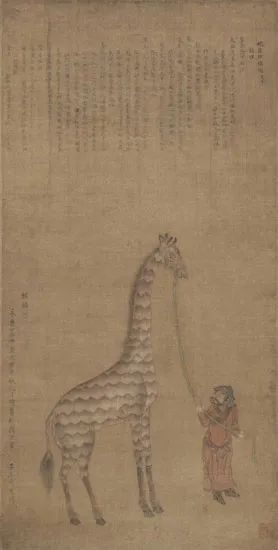The giraffes that sailed to medieval China
- More than 2 years ago
I was recently perusing the gorgeous new tome Giraffe Reflections by Dale Peterson and photographer Karl Ammann and was intrigued by an image of a 13th-century Chinese painting of a zigzag-covered giraffe being led by an attendant. And then I realized that this was a picture of a giraffe that had actually lived in China during that time. How was that possible?
Chinese exploration of the world is often left out of Western textbooks (at least it was left out of mine), but for a brief period, from 1405 to 1433, the Chinese under Ming emperor Yongle sent out numerous trade missions that reached as far as present-day Kenya. During the fourth expedition, which left China in 1413, part of the fleet led by commander Zheng He sailed to Bengal in India, where in 1414 they met envoys from the African coastal state of Malindi (now part of Kenya). The men from Malindi had brought with them as tribute giraffes, and they gave one of those giraffes to the Chinese, who took it home. A year later, Malindi sent another giraffe to China, along with a zebra and an oryx. The fifth Chinese trading expedition then brought back “an arkful of African animals, including antelopes, leopards, lions, oryxes, ostriches, rhinos, zebras — and more giraffes,” Peterson writes.

All the animals were exotic, but the giraffes were particularly special. They were thought to be qilin (or ch’i-lin, as it’s spelled in the book), creatures that are known as Chinese unicorns but are more like a cross between a horse and a dragon. Qilin had several characteristics that the giraffe fulfilled, Peterson writes:
According to Confucian tradition, a ch’i-lin male, aside from his many other wondrous qualities, would be marked by a flesh-covered horn rising from the forehead. Giraffes have skin-covered horns, and some giraffe males develop a skin-covered median horn, a decisive knob or bump that appears at mid-forehead. Ch’i-lin could alternatively have two or three horns, as can giraffes. Confucian tradition also held that ch’i-lin had a deer’s body and cloven hooves, as well as the tail of an ox and, sometimes, the scales of a fish. A giraffe would probably pass that test as well, aside from the fish scales…. Ch’i-lin were usually imagined to be white; but they could be gaily colored in red, yellow, blue, white and black — not entirely unlike a giraffe. Ch’i-lin were associated with gentleness and goodness, qualities that would be at least superficially apparent in a giraffe.
Confucian tradition lists four mythical beasts — qilin, dragon, phoenix and turtle — and possessing one of these miraculous animals may have helped Yongle to cement his legitimacy as the “second” Ming emperor, Peterson notes. Yongle became emperor when his raided Nanjing with an army of several hundred thousand men and set fire to the palace. His brother Jianwen, the second Ming emperor, was accidentally killed in the fire, or so Yongle claimed. Yongle then took his place. But as a fourth son, he may have felt the need to buttress his claim. He rewrote official history to leave out Jianwen (never mind that this had Yongle’s father living for four years after his death). And owning the mythical qilin may have served as useful propaganda for someone who felt his throne wasn’t totally secure, Peterson writes.
The link between the giraffes and qilin was strengthened by the official painting commemorating the event, Oxford scholar Sally Church wrote in The Medieval History Journal in 2004:
Whereas the emperor seems to have played down the supernatural dimension, he still wished to commemorate its arrival, and the painter Shen Du made the association between giraffe and qi-lin explicit both in the style of the painting and in the poem inscribed at the top. Shen Du painted in a delicate, refined style, giving the giraffe a benign, gentle face, a delicate and slender body with a detached, otherworldly majesty. Its spots are no longer spots but are transformed into a fish-scale motif that is characteristic of the qi-lin.
Chinese exploration ended in 1433, nine years after Yongle’s death, when isolationism once again took over Chinese policy. “China perceived her greatest challenges and opportunities to be internal ones,” University of Texas at Austin historian Samuel Wilson wrote in Natural History in 1992. “Restrictions on private trade were reimposed, and…Zheng He’s magnificent ships finally rotted at their moorings.”
As to what happened to the giraffes, I can find no tales. Peterson notes in Giraffe Reflections that by the end of the Chinese Age of Exploration, the “ruling class had become jaded about the exotic animals in the Imperial Gardens, so that only the first two giraffes brought from Malindi by way of Bengal during the fourth expedition were hailed as miraculous apparitions, the true embodiments of ch’i-lin.” Let us hope that those giraffes and their brethren had the chance to aged gracefully and happily, well taken care of, 5,000 miles from their African homeland.






